Felting mats are essential for needle felters. Without them, you cannot felt. There are a few choices that you can get. These depend on personal preference and budget. I have explored the options below with the pros and cons of each.
You can use high-density foam pads or mats, a special felting brush, rice or buckwheat hessian bags, or wool pads & earth mats as a felting mat.
There’s a bit more to it than that. Each type of pad has its strengths and weaknesses and some are better used for one thing than another. You can also either buy, make, or substitute them depending on your needs. I found this to be a bit confusing when I started out so did a bit of research on it. What I found was once you know some basics it’s not as confusing as you think. I bought and used the mats discussed here so I could share my findings here.
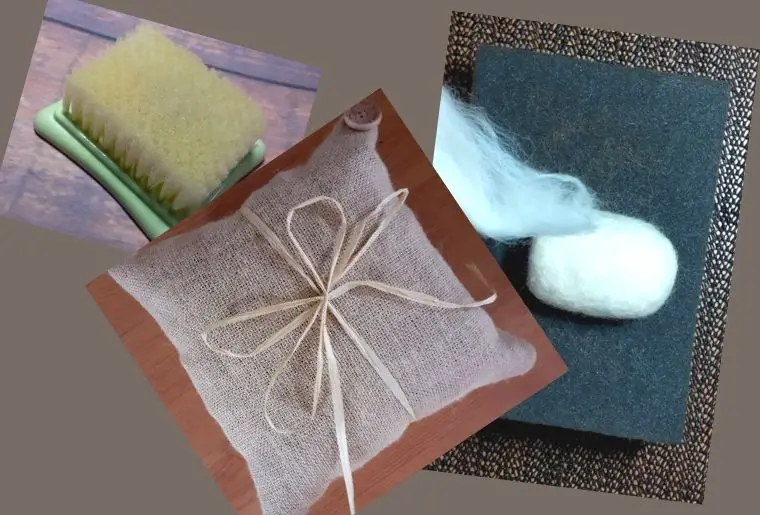
What Can You Use As A Felting mat?
There are several things that you can use as a felting mat.
- High-density foam
- Wool felting mats
- A Brush
- Rice pads
- Buckwheat Hulls pads
To know what type of mat to get its best first to know why you need to use one. This gives you a better chance of deciding which one is right for you.
What Is A Felting Mat & Why Use It?
A felting mat in needle felting is what you place your wool project onto so that you can felt easily and safely while keeping control of your project.
A needle felting mat serves several purposes.
- It protects your needles from hitting the surface beneath and breaking. (Although technically they shouldn’t go that far in for larger projects).
- It allows your project to rest on a firm surface so that you can work on it without it shifting around which is both annoying and dangerous.
- The mats support your project it makes it easier to work on it and position it and aim the needles where you want them to give a more accurate finish.
- It is a safe surface so that you can needle felt safely without injuring yourself.
You use your felting mat beneath your projects for the above-mentioned reasons. What different felters choose to use as a felting mat depends on budget, personal choice, and the project that you are doing.
A felting mat should always be used while felting and placed on a firm surface for safety. Not your legs.
I prefer to use felting foam to felt on for my projects.
What is Felting Foam?
Felting foam is a dense foam that is cut into a rectangular cube shape of different sizes and thicknesses. It is typically gray or blue. It is far denser than your typical bath sponge.
If you press your finger and thumb to each side of the pad it doesn’t squish down like normal sponges.
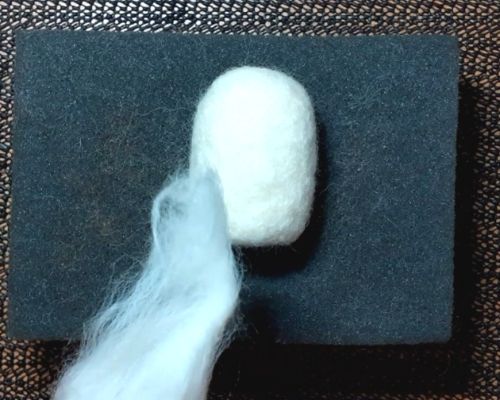
Foam pads are a popular choice as a felting mat among felters especially when they are just starting out. They are cheap, readily available, and easy to use and come in a range of qualities, sizes, and shapes.
Where You Can Buy Your Foam Pads For Felting
Felting foam pads are usually easy to buy online in places like Amazon, eBay, or Etsy.
You can also buy them from the many small needle felting businesses online.
If you are new to felting you can also get them if you buy a beginner’s felting kit. They are usually supplied in those. Make sure you check though as it varies.
Pros of Using Foam to Felt
- Economical to buy
- Easy to use
- Great for both 2D & 3D felting
- Fairly easy to clean
- Firm and flat
- Lightweight
- Widely available
- Comes in a variety of sizes
Cons Of Using Foam Mats
- Not environmentally friendly
- Disintegrate fairly quickly
- I find the centers dip after a while
The foam pads are not very environmentally friendly. They will not break down if they go in the waste.
If you were using the occasional one it wouldn’t be too bad but the pads do break down as you use them so need to be replaced.
Where I live this isn’t an issue because everything is incinerated and the energy created reused on the grid.
If this is a concern you can use one of the other options here that are more environmentally friendly or cover them with a cloth. Or you can use the Earth Mats mentioned below to cover them if they are available in your area.
Felting Foam Alternatives
I recommend that while starting out in your felting journey you start with the foam pad. It is easy to use and meant for the job. I didn’t start with these when I started.
I wanted to keep prices rock bottom so I bought kitchen sponges at a cheap retailer. They worked OK but wore out fast. They aren’t really firm enough for felting and the wool stuck to them like crazy. (I was a bit heavy-handed, lol).
Lots of felters, opt for high-density sponges. While felting sponges are high density these are just upholstery sponges, the kind that goes in furniture. These come in different densities.
If you are doing big projects these are great as you can get them much larger than I have seen felting foam. You can also cut them to size.
As a beginner you don’t need anything this big.
If you decide on this option make sure you get foam that is at least 2” (5cm) in depth.
The price looks comparable to me so unless you can find it cheaper it’s not something that I’d say saves the budget.
Other Surfaces You Can Use As A Felting Mat
The Felting Brush
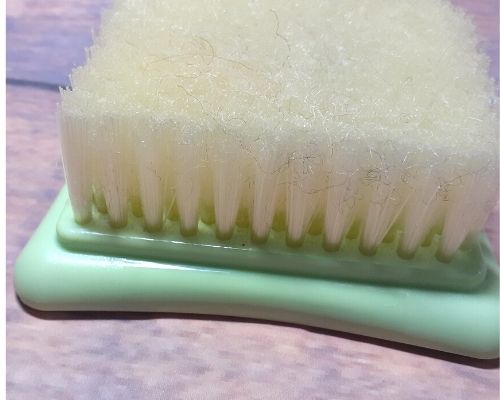
You can use a felting Brush as your felting mat.
These come in different sizes. The 16cm long ones are a good size and classed as large. I haven’t seen anything bigger than this in brushes.
When I first started out I wanted something a bit more permanent than kitchen sponges. My sister had one of these so I borrowed it to see how I got on.
I didn’t!
I was too rough or I missed the wool and caught the brush base. This led me to problems and I was afraid I’d break the needle.
The wool stuck to the bottom and my creations were rough. So I stopped using it.
But a lot of people like these and the reviews are fantastic. So I’ve since done some more research and bought one to give it a second chance now I’m more experienced.
So where did I, like so many others, go wrong?
Firstly it actually says that you should cover the brush with a piece of cloth. This is to prevent the wool from sticking to the brush. I’ve tried it and it does work. You can get a much better finish by using a cloth over the brush.
Overall the brush is quite nice to use. I could use it to create things. But it still has issues at least for me. Other felters highly recommended it.
Felting Brush Pros
- It’s long-lasting and sturdy
- Doesn’t wear down like foam
- Great for felting flat 2D projects
- Easy to clean
- Great for multi-needle use
- Although it’s made of materials that aren’t environmentally friendly, its long-lasting nature makes it more environmentally friendly than the foam pads
Felting Brush Cons
- Limited in size of the project due to brush size
- Can easily damage single needles
- The bristles move when felting smaller projects which is dangerous and annoying. It’s not a lot but enough to either mess up your work or hit your fingers with the needle.
You Can Use A Hessian/Burlap Filled Bag As Your Mat
The Rice Filled Bag
These are very popular among some felters. They are simply a bag filled with cheap rice. These bags are usually made from burlap/hessian but sometimes people use other materials.
Pros of Rice Bags for Felting
- Very environmentally friendly
- Biodegradable
- Long-lasting
- Firm easy to use surface
- Can be any size or shape
- Hold the project well
- Less likely for the needle to go through and damage your surface beneath
- Can make them yourself if you want
Cons of Rice Bags
- Need to freeze rice to avoid bugs in your bag! (if making your own or filling a pre-bought bag.
- Harder surface for the needle to hit. Can wear down needles faster
- Can be expensive to fill
- Heavy especially if you have them on your lap. (Which I don’t recommend for safety reasons).
- Often just get the bag and agave to fill it yourself due to weight issues
Buckwheat Hulls Make Great Needle Felting Pad/Mats
Buckwheat felting mats are like the rice felting mats only filled with buckwheat. They come with hessian/burlap material outer covering.
I didn’t know these existed until recently. They have all the advantages of rice pads/mats but have very few of the disadvantages. Except they are not widely available.
They also have all of the advantages of the foam pads and few of the disadvantages.
Note: Make sure you use only hulls and not the seeds as the seeds do attract bugs and do degrade over time. Most people selling them will use hulls.
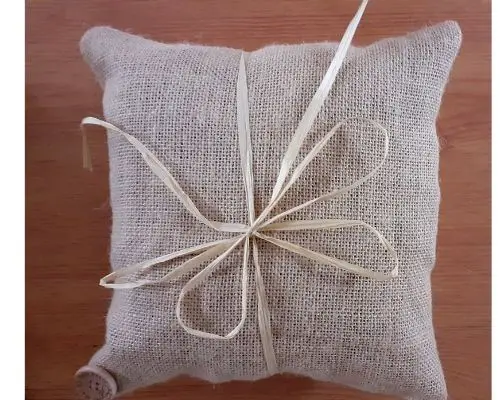
Pros of the Buckwheat Felting Mat
- Environmentally friendly
- Biodegradable
- Lighter than rice bags
- Easy to clean
- Long-lasting
- Ideal for those suffering from mobility problems because they are lightweight
Cons of the Buckwheat Mat
- Hulls will degrade over time
- Burlap/hessian will be rougher on the needles than foam
- Very few suppliers
- Not readily available everywhere (readily available in the UK, Some availability in the USA).
My Buckwheat Mat
The picture above is of my buckwheat felting mat. It was a bit of an adjustment going from the foam pad to this type of mat.
I found using it confirmed much of the research I’d done on it. It is lightweight. Yet it is also firm and holds my projects well.
Due to the curved edges, the amount of surface you have to work on is reduced compared to a foam pad. This isn’t an issue if you do smaller projects or if you are only working on part of a larger one as it still holds well.
I do find the needle hits the hessian/burlap and it catches and stops the needle more than foam would. I am certain this wears out the needle and increases the chance of needle breakage.
It also feels higher than the foam mats. Some of my mats are quite thin and I can feel the difference.
The lady that makes these did a really great job of it. They are well made and as you can see the attention to detail is good.
Wool Needle Felting Mats
Wool needle felting mats are mats made of wool and used to be felted on.
This always sounds like a contradiction to me!
After all, the majority of the process of felting is to join wool to wool with a needle. But there does come a point where the wool does become too tight to felt together more.
After my initial skepticism, I decided to try it on a felted my own pillow as a trial run.
It went surprisingly well. It was comfortable to use. The wool stayed where it was meant to. But it did pull some of the wool up so would need to be felted a lot more to prevent or reduce this. Or it could be covered with some material.
Pros of the Wool Felting Pads
- Lightweight easy to carry with you
- Sturdier than foam
- Environmentally friendly
- Lasts for years
- Reasonably priced
- Quiet when felting
- Quite deep so good to felt on
- Quiet to use
Cons of the Wool Felting Pads
- Sometimes the wool does felt to the pad (but then it can with either method too)
- If wool does stick its harder to clean
- Some brands discolor your wool
You can buy these either as wool pads or as wool pds with a top layer.
Earth Needle Felting Mats
Earth felting mats are a very good option. They can be used for either 3D or 2D felting. Each mat is quite thin. You need 2 mats one soft and one firm if you are using them on their own.
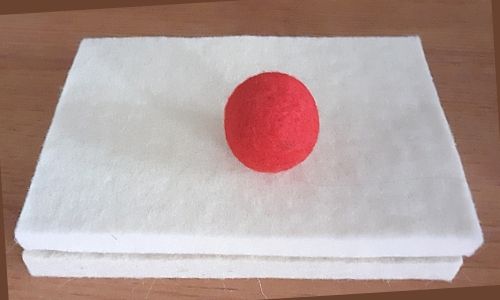
They come in a good range of sizes. 4 rectangular sizes from small – A6 (10cm x 15cm) (A5 & A4) to extra large A3 (42cm x 29.7cm and 2 special square sizes. 30 x 30cm (11.8”x11.8”) and 42.5cm (16.7”x16.7”).
They are environmentally friendly and although they do last a long time the soft mat does wear out. The soft mat is made of 100% wool which is biodegradable and you can compost it as well.
The firm under mat is mostly made out of wool but also 30% man-made materials to make it firmer. You shouldn’t need to replace this mat though. That also makes replacements more economical as you only need to buy the soft mat replacement.
I like the way you can either use them as a pair with one firm and one soft or with your other mats. They are perfect for putting on top of the foam pads as they do wear down in the middle quite fast. You’d only need to get the softer top mat to do this.
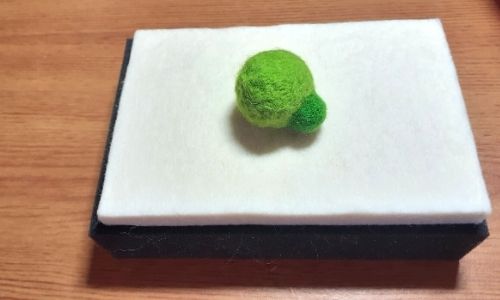
I love that you can cut them to size. So I could use them with my other mat without any overhang. These must be a 2D felters dream, to have a mat that you can have flat and large enough for your projects without needing to move them.
Pros of the Earth Mat
- Easy to clean
- Long-lasting
- Flexible use
- Biodegradable soft part
- Environmentally friendly
- Can be cut to whatever size you want
- Available in several different sizes
- Can buy just the top or the bottom mat
- Can layer them to how thick you want them
- Can be used on top of your other bags or foam to prolong their life, keep them clean, or for softer felting*
*I love this idea as whatever you use to felt on there is usually wool stickage or in the case of foam they wear out quickly. This would prolong their life making them more environmentally friendly.
Cons of the Earth Mat
- I can only find these in one store in the UK. I think they are specific to that store. They do ship worldwide.
- They are thin. I’m not happy with that thickness no matter how dense the bottom layer. Although it’s unlikely that the needle will go through to the bottom. This is where the foam earth mat combo is a good idea. You can see the way I have used it here in my pictures. Where I do like the thickness is the mat isn’t so high to work on which is lovely.
- Some wool will stick to the pad (this happens whichever method you use)
Comparison Chart of Felting Mats/Pads
| Foam | Buckwheat | Rice | Brush | Earth | |
| Easy on Needles | Yes | No | No | No | Yes |
| Different Sizes | Yes | Yes | Yes | No | Yes |
| Cut to Size | Yes | No | No | No | Yes |
| Cheap to Buy | Yes | No | No | No | No |
| Cost Effective | No | Yes | Yes | Yes | Yes |
| Long Lasting | No | Yes | Yes | Yes | Yes |
| Env Friendly | No | Yes | Yes | Yes | Yes |